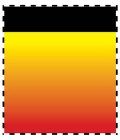The Federal Circuit recently held in a precedential ruling that a "color mark" comprising a multiple-color pattern is capable of being inherently distinctive and of registration on the Principal Register, so long as it appears on product packaging rather than on a product itself.
In In re Forney Industries, No. 2019-1073, applicant Forney sought registration on the Principal Register for a mark comprising a pattern of colors on product packaging and labels—a black band above a gradient of yellow shading into red.

The examining attorney rejected the proposed mark and the TTAB affirmed the rejection, stating that Supreme Court precedent dictated that color marks were incapable of possessing inherent distinctiveness and thus were eligible for initial registration only on the Supplemental Register, with later registration on the Principal Register contingent upon a showing of acquired distinctiveness. The Board also offered, as an alternative ground of rejection, the fact that there was no peripheral shape or border delimiting the appearance of Forney's gradient on packaging – the pattern alone had been applied for.
On appeal from the TTAB, the Federal Circuit criticized the Board's analysis of Supreme Court precedent on trade dress and color marks, including Two Pesos, Inc. v. Taco Cabana, Inc., 505 U.S. 763 (1992), Qualitex Co. v. Jacobson Prod. Co., 514 U.S. 159 (1995), and Wal-Mart Stores, Inc. v. Samara Bros., 529 U.S. 205 (2000). The Federal Circuit found that the Board had over-read the decisions to reach the mistaken conclusion that color marks could not be inherently distinctive regardless of their use on products or on packaging.
Specifically, the Federal Circuit observed that while some dicta in Qualitex implied that a color mark would only be registrable if it had acquired secondary meaning, the case "did not expressly so hold." (Slip op. at 9). Conversely, in Two Pesos, the Court had assumed without deciding that restaurant trade dress including a vivid color scheme was inherently distinctive, suggesting that such inherent distinctiveness was cognizable when applied to something other than the sold products themselves. Likewise, while Wal-Mart contained some language suggesting that color marks were per se incapable of inherent distinctiveness, the fuller context of the case drew an important distinction between product design trade dress (which could never be inherently distinctive) and product packaging trade dress (which could be), as reflected in later Federal Circuit discussion of Wal-Mart in In re Chippendales USA, Inc., 622 F.3d 1346, 1357 (Fed. Cir. 2010). (slip op. at 9).
In view of Forney's application for registration for packaging purposes and further in view of the application's use of multiple colors rather than a single color, the Federal Circuit concluded that the Board had erred in holding multi-color trade dress incapable of having inherent distinctiveness in all circumstances. Instead, an application for a multi-color packaging color mark should be assessed for the relevant factual determination of inherent distinctiveness rather than rejected as a matter of law.
Addressing the Board's alternative conclusion that a color mark could only be inherently distinctive if used with a distinctive peripheral shape or border, the Federal Circuit rejected this argument for lacking any basis in applicable case law. Rather, the test for packaging trade dress marks remained that enumerated in Seabrook Foods, Inc. v. Bar-Well Foods Ltd., 568 F.2d 1344 (C.C.P.A. 1977), whether the applied-for dress "'makes such an impression on consumers that they will assume' the trade dress is associated with a particular source." (slip op. at 10), requiring an assessment of the following factors:
- whether the trade dress is a "common" basic shape or design;
- whether it is unique or unusual in the particular field;
- whether it is a mere refinement of a commonly-adopted and well-known form of ornamentation for a particular class of goods viewed by the public as a dress or ornamentation for the goods; or,
- whether it is capable of creating a commercial impression distinct from the accompanying words (if applicable).
(slip op. at 10) (citing Seabrook). The Federal Circuit agreed that the applicant's mark was certainly capable of possessing inherent distinctiveness under the above rubric, particularly as it sought registration for a multi-color pattern rather than merely a uniform color or the presence of colors. (slip op. at 11) (citations omitted). The Board's obligation was, therefore, to assess the mark's overall visual impression as a pattern qua pattern, rather than eliding the distinction between single colors and multi-color patterns as the Board's reasoning had previously done.
In the wake of Forney, applicants seeking registration for multi-color patterns applied to product packaging (rather than only the color of the product design itself) are well-situated to seek protection for such patterns on the Principal Register. In turn, this makes packaging patterns a potentially much more attractive area for creativity and branding than it may have been in the past.
The content of this article is intended to provide a general guide to the subject matter. Specialist advice should be sought about your specific circumstances.


